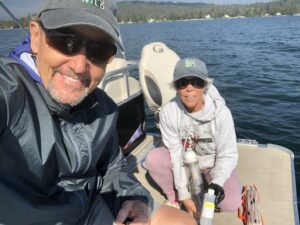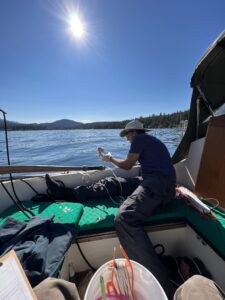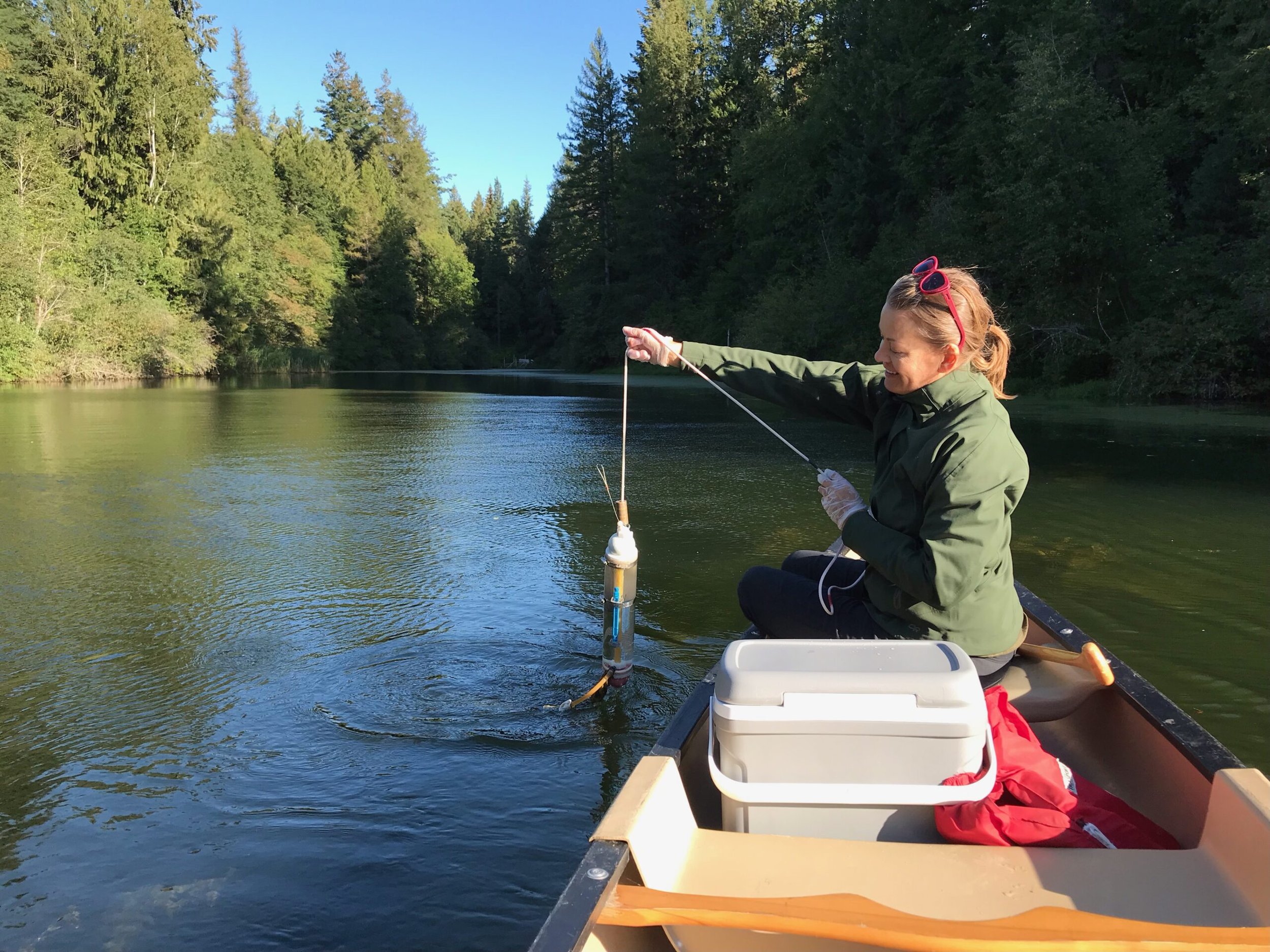Water Quality Monitoring: How ICL’s citizen science program helps protect Lake Pend Oreille
This summer, ICL took the reins of a program that Lake Pend Oreille Waterkeeper implemented for the last 10 years, and began water quality monitoring in Lake Pend Oreille. Dedicated citizen scientist volunteers monitored 13 sites for 11 different water quality parameters over 5 months this summer – adding up to 715 data points that provide a clear snapshot of the health of our magnificent lake. This data supports our advocacy work to keep Lake Pend Oreille swimmable, fishable, and drinkable for all. Lake Pend Oreille is vast and beautiful; it’s 1149 feet deep with 111 miles of shoreline. While the lake’s great volume means it can assimilate quite a bit of pollution without detrimental effects, the water closer to the shoreline is more vulnerable to pollution generated by human activities on the land nearby. This water, generally within 50 feet from the shoreline, and specifically the area where light can penetrate to the lakebed, is called the ‘nearshore’ area.More than 25 years ago, it was determined that under the Clean Water Act, the nearshore area of Lake Pend Oreille was at risk of not meeting its beneficial uses for primary contact recreation – meaning it was at risk of not being swimmable. Reports of algae and weed growth led to increased citizen concern and involvement. Thanks to this citizen involvement, the Idaho Department of Environmental Quality (IDEQ) and partners wrote an improvement plan called a Total Maximum Daily Load (TMDL) and water quality standards, which limit the amount of a pollutant that is allowed to enter the water. In this case, the limits were for phosphorus, which feeds algae and weeds.A component of these standards is a detailed clean-up plan for human-caused pollution. The purpose is to curb pollution that flows into the lake and feeds the algae and weeds that diminish our recreation opportunities with this special water body. It includes specific management actions, which if executed, would ensure the lake continues to offer opportunities to enjoy it in the future.
Lake Pend Oreille is vast and beautiful; it’s 1149 feet deep with 111 miles of shoreline. While the lake’s great volume means it can assimilate quite a bit of pollution without detrimental effects, the water closer to the shoreline is more vulnerable to pollution generated by human activities on the land nearby. This water, generally within 50 feet from the shoreline, and specifically the area where light can penetrate to the lakebed, is called the ‘nearshore’ area.More than 25 years ago, it was determined that under the Clean Water Act, the nearshore area of Lake Pend Oreille was at risk of not meeting its beneficial uses for primary contact recreation – meaning it was at risk of not being swimmable. Reports of algae and weed growth led to increased citizen concern and involvement. Thanks to this citizen involvement, the Idaho Department of Environmental Quality (IDEQ) and partners wrote an improvement plan called a Total Maximum Daily Load (TMDL) and water quality standards, which limit the amount of a pollutant that is allowed to enter the water. In this case, the limits were for phosphorus, which feeds algae and weeds.A component of these standards is a detailed clean-up plan for human-caused pollution. The purpose is to curb pollution that flows into the lake and feeds the algae and weeds that diminish our recreation opportunities with this special water body. It includes specific management actions, which if executed, would ensure the lake continues to offer opportunities to enjoy it in the future.  Phosphorus pollution comes from a variety of sources, including sediment released from earth disturbing activities, fertilizer application on crops and lawns, septic systems, and sewer discharges. The clean-up plan includes specific actions that are needed by Bonner County, Panhandle Health District, Idaho Department of Environmental Quality, Army Corps of Engineers, and others, with timelines and funding sources identified to address and limit the pollution. Mandatory septic inspections and upgrades, science-based buffer zones for waterfront development, sewer treatment facility connections for developments, constraints on fertilizer use, and extensive public education are all part of this plan. ICL’s Water Quality Monitoring Program (WQMP) plays a vital role in this, as the program’s goals are to inform the public and provide high-quality scientific data that regulatory agencies can use when making decisions that will impact our local waterways.
Phosphorus pollution comes from a variety of sources, including sediment released from earth disturbing activities, fertilizer application on crops and lawns, septic systems, and sewer discharges. The clean-up plan includes specific actions that are needed by Bonner County, Panhandle Health District, Idaho Department of Environmental Quality, Army Corps of Engineers, and others, with timelines and funding sources identified to address and limit the pollution. Mandatory septic inspections and upgrades, science-based buffer zones for waterfront development, sewer treatment facility connections for developments, constraints on fertilizer use, and extensive public education are all part of this plan. ICL’s Water Quality Monitoring Program (WQMP) plays a vital role in this, as the program’s goals are to inform the public and provide high-quality scientific data that regulatory agencies can use when making decisions that will impact our local waterways. Through the WQMP, dedicated citizen scientist volunteers collect water samples at sites across Lake Pend Oreille and the Pend Oreille River. Taking these measurements on a regular basis over many years helps us understand our local waterways and the overall health of our lake and river systems, including the nearshore area that needs to be cleaned up.Preliminary results from the 2022 monitoring season show that phosphorus pollution remains a problem in parts of this nearshore area. Coupling that knowledge with recent toxic algae blooms and continued invasive weed growth, we know we have a lot of work to do.
Through the WQMP, dedicated citizen scientist volunteers collect water samples at sites across Lake Pend Oreille and the Pend Oreille River. Taking these measurements on a regular basis over many years helps us understand our local waterways and the overall health of our lake and river systems, including the nearshore area that needs to be cleaned up.Preliminary results from the 2022 monitoring season show that phosphorus pollution remains a problem in parts of this nearshore area. Coupling that knowledge with recent toxic algae blooms and continued invasive weed growth, we know we have a lot of work to do. The IDEQ will soon lead a review of the TMDL. This review, along with our own water quality data, helps guide ICL in how we prioritize our advocacy work in the future. It will ensure we know where the worst pollution problems are and how to focus our work to minimize or eliminate them. We will use this information to make sure the agencies are accountable for actions that were outlined for them almost 20 years ago. This lake is too precious to lose – ICL and our citizen scientist team will continue working to keep it swimmable, fishable, and drinkable for all. Stay tuned this winter for a full review of the summer’s water monitoring results, in comparison to the past 10 years. And THANK YOU to the citizen scientists who make the water quality monitoring program work, and dedicate their time to protecting our cherished lakes in North Idaho.Anyone can become a citizen scientist! Interested in becoming a volunteer for ICL’s Water Quality Monitoring Program? Find out more here or sign up to be notified about upcoming training sessions for the program by emailing northidaholakes@idahoconservation.org Training sessions for the WQMP will also be posted on our “Upcoming Events” page when they are scheduled.
The IDEQ will soon lead a review of the TMDL. This review, along with our own water quality data, helps guide ICL in how we prioritize our advocacy work in the future. It will ensure we know where the worst pollution problems are and how to focus our work to minimize or eliminate them. We will use this information to make sure the agencies are accountable for actions that were outlined for them almost 20 years ago. This lake is too precious to lose – ICL and our citizen scientist team will continue working to keep it swimmable, fishable, and drinkable for all. Stay tuned this winter for a full review of the summer’s water monitoring results, in comparison to the past 10 years. And THANK YOU to the citizen scientists who make the water quality monitoring program work, and dedicate their time to protecting our cherished lakes in North Idaho.Anyone can become a citizen scientist! Interested in becoming a volunteer for ICL’s Water Quality Monitoring Program? Find out more here or sign up to be notified about upcoming training sessions for the program by emailing northidaholakes@idahoconservation.org Training sessions for the WQMP will also be posted on our “Upcoming Events” page when they are scheduled.

